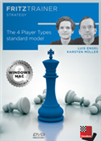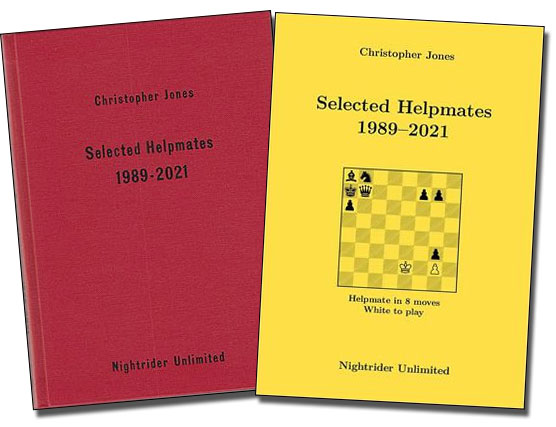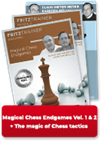Review by Ian Watson
Christopher Jones is a Grandmaster of Chess Composition, a title that, unlike the over-the-board GM title, is awarded to few. It is conferred for the elegance and originality of the problems entered in composing tournaments. Christopher, however, also composes problems for use in solving competitions; indeed, he is the go-to composer for helpmates for use in the World Chess Solving Championship and other major events.
 Playing styles in chess are an important and thus often discussed topic. GM Dr. Karsten Müller and GM Luis Engel take up a model by GM Lars Bo Hansen based on 4 player types - namely ‘activists’, ‘pragmatics’, ‘theoreticians’ and so-called ‘reflectors’.
Playing styles in chess are an important and thus often discussed topic. GM Dr. Karsten Müller and GM Luis Engel take up a model by GM Lars Bo Hansen based on 4 player types - namely ‘activists’, ‘pragmatics’, ‘theoreticians’ and so-called ‘reflectors’.Most helpmates have two or more solutions; in solving competitions, finding one solution should not immediately make the other solutions obvious to the solver, and some composers achieve that by making the other solutions utterly different with no thematic relationship at all. Somehow, Christopher succeeds in making his compositions have unified solutions but ones that don’t betray each other – when you see the full set of solutions, you realise they are harmonious, but that he’s disguised it. I like being deceived like that.
Christopher’s specialism is the world of helpmates – chess problems in which White and Black cooperate together to give mate to the black king. I may be biased, but for me he is the world’s leading helpmate composer. This book is ample evidence.

I’m an avid solver of chess problems, and this book is ideal for that. You can keep it by the bedside and attempt one before your brain starts to shut down for the night
Published in 2022 by Nightrider Unlimited. Softback, 119 pages. A small hardcover edition of 25 copies (cloth-bound; in the usual get-up of the red K/M Series) is now available (end of March, 2022).
Orders by e-mail to ralf.kraetschmer@t-online.de
You can browse this book, and simply play through the solutions, but to my mind that’s defeatism – why not have a crack at solving them? If you succeed, you feel elated. If you have to surrender (and peek at the solutions pages), yes, you’ll be frustrated, but only briefly because then you’ll be gawping at the ingenuity. I’m an avid solver of chess problems, and this book is ideal for that. You can keep it by the bedside and attempt one before your brain starts to shut down for the night, though you might end up sleepless, especially if you try the longer problems. If you really need a full night’s sleep, you can always sneak to the solutions pages. I hate doing that, but sometimes you’ve got to admit the composer has beaten you (dammit).
Let me talk you through the problem on the book’s front cover. White moves first and delivers mate on his eighth move. An eight-mover is tough, unsolvable by brute force analysis. So, we need clues.
In helpmates, identifying where the black king is likely to be mated is a good starting method. It feels likely to be on a7, because there’s that nest of black pieces and especially that pawn on a6 which must have some function and most likely is to block in the black king.
 In over 4 hours in front of the camera, Karsten Müller presents to you sensations from the world of endgames - partly reaching far beyond standard techniques and rules of thumb - and rounds off with some cases of with own examples.
In over 4 hours in front of the camera, Karsten Müller presents to you sensations from the world of endgames - partly reaching far beyond standard techniques and rules of thumb - and rounds off with some cases of with own examples.Next, what piece mates? White has only one piece to mate with, and it’s hard to see how the pawn could capture f3/e4/d5/c6/b7, so it’s going to have to promote. So, Black’s first move is going to be ...Qf3, otherwise we’ll go beyond the eight moves. That suggests that White’s moves 2 and onwards might be gxf3, f4 f5, f6, fxg7, g8=something and then the mating move. If that’s with the black king on a7, it’s going to have to be 8.Qg1, so the g3 pawn is going to have to promote to clear the file. For it to be mate, you’ll need the black bishop on b7, not the black queen, so the black promoted pawn has to get to a8.
The rest is straightforward, once you realise the black bishop will have to go to h1 to clear the way for the new black queen. Fine, and dandy even, but look at what Christopher has done: a Phoenix queen (it dies and is reborn); the bishop moves corner-to-corner; the queen and the bishop have swapped places between the diagram and the mating position; the B/Q arrangement has moved from a8/b7, turned round as a Q/B arrangement on g2/h1 and then slid back all the way up to the top left corner; oh, and White’s pawn has advanced all the way from home to promotion. And there are the details that are easy to not notice: for example, the first move has to be ¢d3 – on any other square the white king would get checked later.
In most composers’ oeuvre, that would be their pièce de résistance; here, it is merely one among very many – hundreds of examples of grandmastery. You will be gawping (and you will be sleepless).
Solution to the helpmate: 1.Kd3 Qf3+ 2.gxf3 g2 3.f4 g1=Q 4.f5 Bh1 5.f6 Qg2 6.fxg7 Qa8 7.g8=Q Bb7 8.Qg1#. You can move the pieces on the diagram above to replay it, and see why any other key move does not work).

The above article appeared in the January 2023 issue of The British Chess Magazine, the world's oldest chess publication. It is reproduced with kind permission.
BCM covers the international and British chess scene. In a blend of current event coverage and thought-provoking analysis of the chess world’s most topical issues, BCM gives readers what they need to understand and enjoy the Royal Game and its wider context in society.
BCM’s interviews with top players and key chess world influencers and participants (actors, businessmen, artists, politicians, top chess world administrators), detailed games analysis and historical articles provide in-depth coverage of chess events and wider chess themes.
Published monthly, each issue of The British Chess Magazine contains 64 pages packed with exclusive articles and annotations. You can buy a subscription – £55 per year, £4.58 per issue.

























